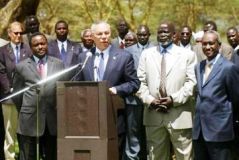Sudan peace mediator heaves sign of relief
NAIROBI, Kenya, Jan 4, 2005 (PANA) — Chief mediator General Lazarus Sumbeiywo
conceded here Tuesday that negotiating the final accord due
signing next Sunday to end 21 years of fighting in southern Sudan
was, in many ways, a “mission impossible”.

|
|
File photo showing U.S. Secretatry of State Colin Powell stands next to Sudanese rebel leader John Garang, center right, and Sudanese Vice President Ali Osman Mohammed Taha, right, after holding talks with the pair near the Kenyan town of Naivasha on Wednesday, Oct. 22, 2003. In this trip Powell exhorted the Sudanese parties to conclude a peace agreement (AP). |
“It was a monumental task, nearly mission impossible,” the
retired Kenyan General who moderated the talks between Khartoum
and rebels of the Sudan Peoples Liberation Movement/Army (SPLM/A)
told a news conference in Nairobi.
Also speaking at the news conference, Kenya Regional Cooperation
minister John Koech concurred that it took sleepless nights to
get the warring parties agree on even ordinary details.
Sumbeiywo, who was briefing journalists on arrangements for the
signing of a comprehensive peace accord, recalled how he gambled
with the heads of the two delegations – Sudan’s Vice President
Ali Osman Taha for the government side, and SPLM/A leader John
Garang.
“I feel humbled that actually God chose me to broker peace in
this conflict,” Sumbeiywo declared.
The talks dating back to early 2002 covered several issues
including the sharing of power and wealth during a six-year
transition to a referendum on independence for the south. In all,
six protocols were signed ahead of the final peace agreement.
“We have catalogued the six protocols according to their
implementation time frames,” Sumbeiywo said.
At one time, Garang said the talks were like a minefield, full of
hilly mountains and rough terrain.
“Whenever you think you have surmounted the hills and hope that
the terrain would be clear, something pops up,” Garang told the
UN Security Council meeting in Nairobi in November last year.
Some of the peace accords signed along the way include a security
protocol, a power-sharing arrangement which gives Garang the
position of First Vice President, and 30 percent representation
of the south in the government.
There is also a protocol on the three disputed areas – Nuba
Mountains, the Southern Blue Nile and Abyei – where special
arrangements will be in force.
The negotiations faced hurdles, characterised by walkouts as both
sides occasionally protested military incursions on the ground.
“The death of Kenya’s Vice President Michael Wamalwa made me to
ask Taha to appear on behalf of Garang, which he declined, that
tells you how difficult it was to bring the two parties to the
table.
The most notable setbacks were battles to control the southern
towns of Torit and Kapoeta, while talks were underway in Kenya,
in violation of a mutual agreement to stop fighting.
The penultimate phase of the talks were characterised by a bitter exchange, with Garang accusing the government of reneging on earlier agreements on the sharing of wealth as well as deliberately trying to shield information on oil revenue.
The peace deal does not cover the conflict in the western region of Darfur.
Sumbeiywo said that it was through the will of God that two sides last Friday managed to finalise the details of the peace deal to end the conflict.
Several presidents and heads of government are expected to attend
the signing of the final accord in Nairobi. Also due here for the
landmark event is former US president Jimmy Carter.
The peace would end a war that erupted in September 1983 when
rebels of the mainly Christian and animist south rose up against
Khartoum’s Arab and Muslim domination.
The war left at least 1.5 million people dead and four million more displaced.
